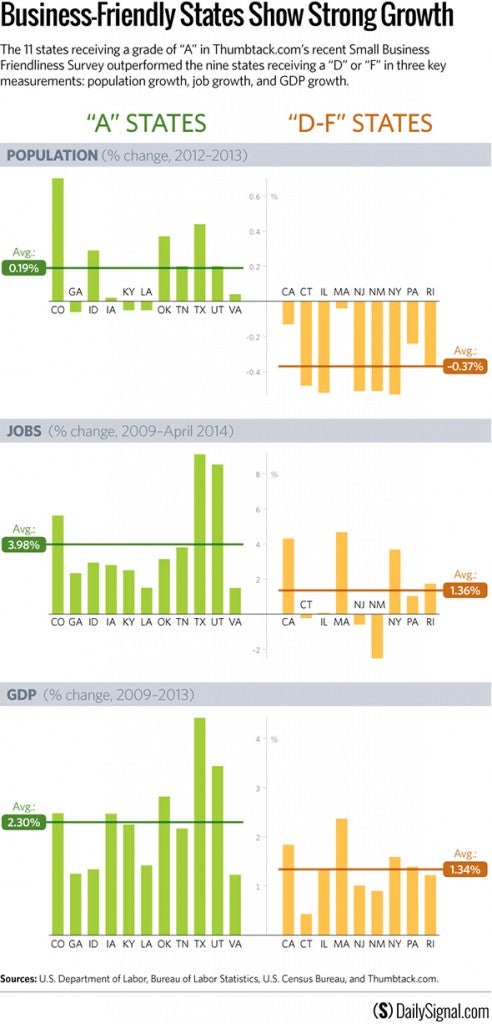Small-Business Friendly States Experiencing Higher Growth
Stephen Moore / Joel Griffith /
Eleven state governments received “D’s” or “F’s” in terms of small business friendliness, according to an annual survey of business owners conducted by Thumbtack.com. Rhode Island, Illinois, and California all failed. Nine state governments received “A” marks. Utah, Idaho, and Texas led the pack.
This survey quantified the bureaucratic obstacle course which entrepreneurs attempting to succeed must navigate. Nearly 13,000 business owners from 38 states rated their state governments on 11 metrics, including the following:
- ease of starting a business
- ease of hiring
- health and safety regulations
- employment, labor, and hiring regulations
- tax code
- licensing, environmental, and regulations
Does the “friendliness” of a state government have consequences beyond how a business owners feels? Official government statics show starkly different economic results between the “A” states and the “D”/”F” states. In short, the business-friendly states tend to trounce the others in several key measures. This should come as no surprise. Government barriers to business creation, disincentivization of risk taking with high taxes, and over-regulation thwart growth. And when possible, job creators often seek to escape oppressive environments, pursuing their dreams in a more welcoming region.
Take a look at this chart to see for yourself. We’ve contrasted performance of the two groups of states in the following three areas: compound annual Gross Domestic Product (“GDP”) growth, relative domestic population growth, and jobs growth. The differences in average outcomes are stark indeed.
Each of the nine states deemed most unfriendly to small business lost domestic population in 2012, for an average loss of 0.37 percent. Of the 11 states deemed most friendly to small business, 8 gained domestic population in 2012, for an average gain of 0.19 percent. Since the start of 2009, the non-friendly states experienced an average of just 1.36 percent total jobs growth. In fact, three of these states lost jobs over the period!
The “A” states, on the other hand, experienced 3.98 percent jobs growth on average—a rate nearly triple that of the least small-business friendly states. And what about the compounded real GDP growth from 2009-2013? The most hostile states grew an average of just 1.34 percent a year. The business-friendly states grew an average of 2.3 percent a year.
This Thumbtack survey should be a wake-up call to those state governments earning low marks. The squeeze on business owners extends throughout the broader community. A smaller economic pie means fewer jobs, less products and services available for consumption, and lower income levels. Without common sense regulatory and tax reform, growth will hampered and prosperity curtailed.

